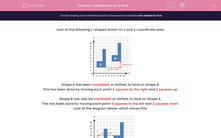Look at the following L-shapes drawn on x and y-coordinate axes.

Shape A has been translated, or shifted, to land on Shape B.
This has been done by moving each point 5 squares to the right and 2 squares up.
Shape B can also be translated, or shifted, to land on Shape A.
This has been done by moving each point 5 squares to the left and 2 squares down.
Look at the diagram below, which shows this.

Notice that in translations, the shapes are not rotated or reflected.
They stay the same way up, but just in a different place on the grid.








